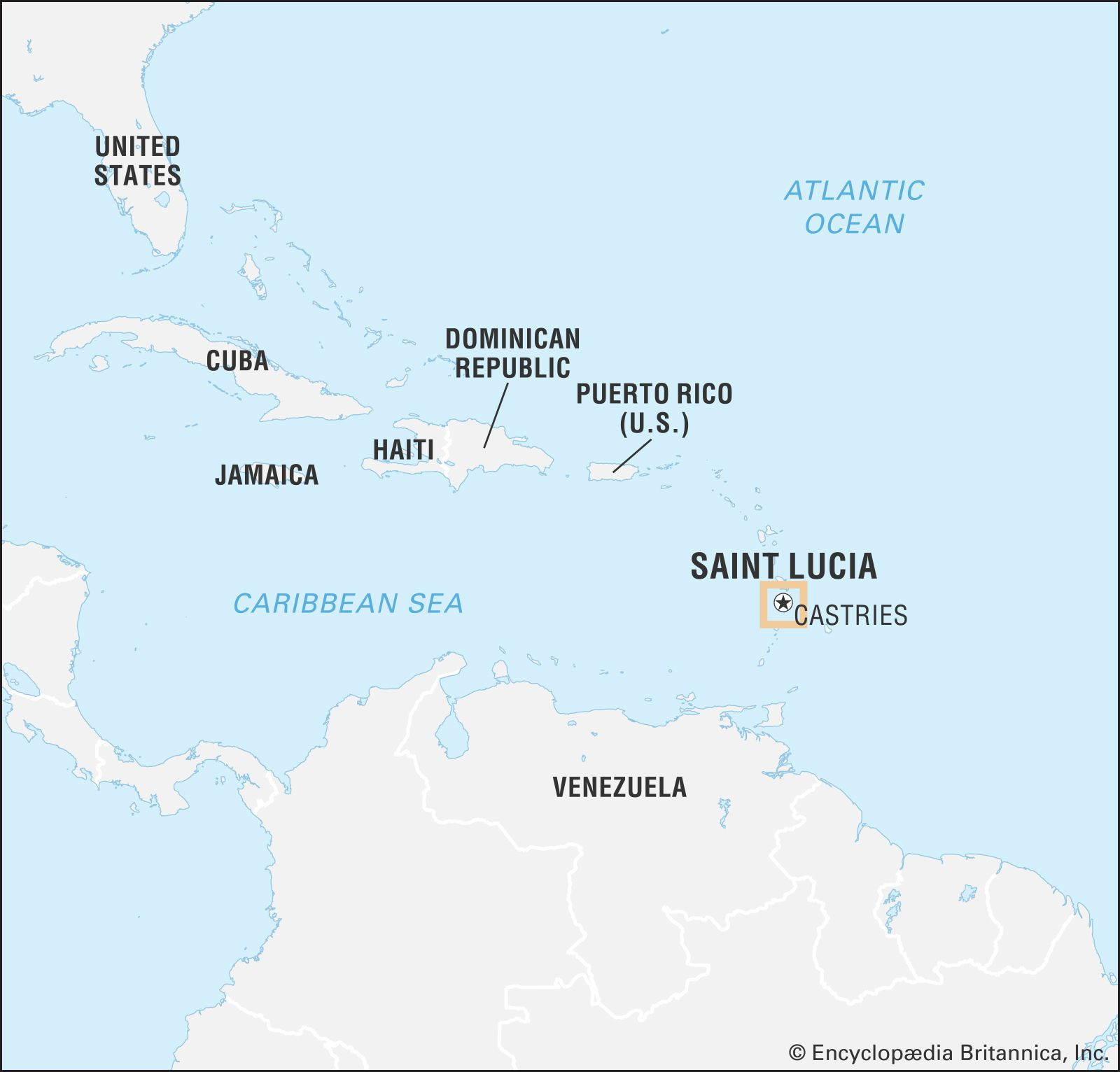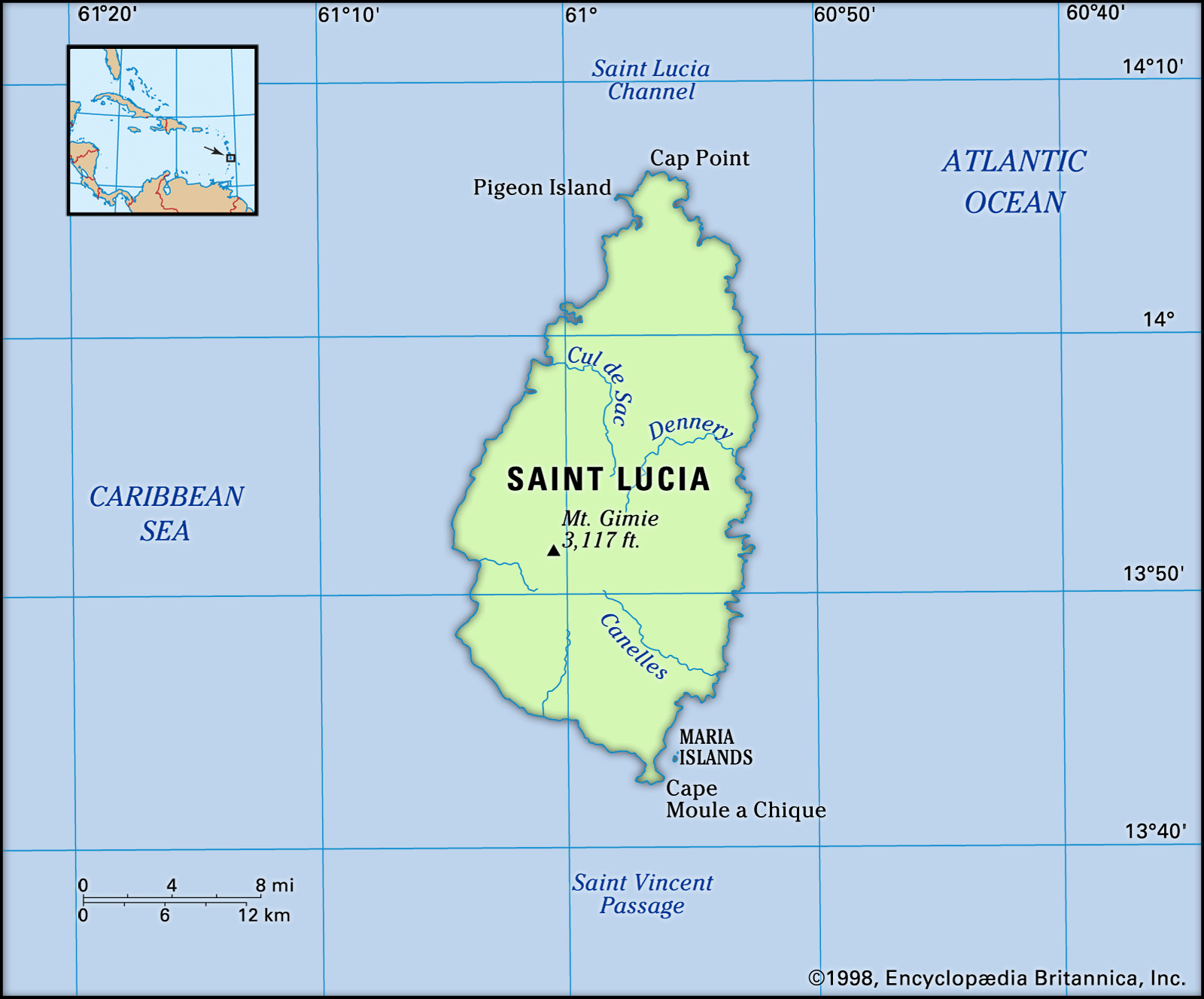Saint Lucia, a captivating island nation, beckons travelers with its stunning landscapes and vibrant culture. But before you pack your bags for this Caribbean paradise, you might be asking: just where is St. Lucia in the Caribbean? Nestled in the eastern Caribbean Sea, Saint Lucia is part of the Windward Islands, a southern group within the Lesser Antilles archipelago. To pinpoint its location more precisely, it lies approximately 24 miles (39 kilometers) south of Martinique and about 21 miles (34 kilometers) northeast of Saint Vincent. This strategic location places it amidst some of the most idyllic and sought-after destinations in the West Indies.
Unveiling Saint Lucia’s Geography and Key Features
This sovereign island state, a member of the Commonwealth, boasts a length of 27 miles (43 km) and a maximum width of 14 miles (23 km). Its capital city, Castries, serves as the major port and a bustling hub of activity. Saint Lucia’s topography is as diverse as it is beautiful. Born from volcanic activity, the island is characterized by a central ridge of verdant, wooded mountains that run from north to south. Mount Gimie, the highest peak, reaches an elevation of 3,145 feet (959 meters), offering panoramic views of the surrounding landscapes.
Numerous streams cascade down from these mountains, carving out fertile valleys that contribute to the island’s lush vegetation. Perhaps the most iconic geographical features are the Gros and Petit Pitons, located in the southwest. These dramatic, pyramid-shaped volcanic plugs rise majestically from the sea, reaching heights of 2,619 feet (798 meters) and 2,460 feet (750 meters) respectively. They enclose a picturesque bay and stand as testaments to the island’s volcanic origins and natural splendor. Close to Petit Piton, within the caldera of an ancient volcano, lie the Sulphur Springs near Soufrière. This popular tourist attraction not only showcases the island’s volcanic nature but also hints at its geothermal energy potential.
Climate, Nature, and People
Saint Lucia enjoys a tropical maritime climate, influenced by the consistent northeastern trade winds. Rainfall varies significantly across the island, from an average of 51 inches (1,295 mm) along the coast to a generous 150 inches (3,810 mm) in the mountainous interior. The island experiences a drier period from roughly January to April and a wetter season between May and November. Temperatures remain consistently warm, averaging around 80 °F (27 °C), with occasional highs in the upper 80s (31 °C) and lows in the upper 60s (20 °C).
The island’s flora is rich, though lumbering has reduced the forest cover. Colorful orchids and anthurium thrive, adding to the vibrant natural tapestry. Birdlife is abundant and diverse, including the Saint Lucian parrot (Amazona versicolor), the island’s endangered national bird, along with the Saint Lucia black finch and the Saint Lucia oriole. Unique fauna also includes a lizard species endemic to Saint Lucia, and the agouti is a common sight.
The population of Saint Lucia is predominantly of black African descent, with a smaller percentage of mulattoes and mixed-race individuals. Minority groups include those of white or East Indian heritage. While a French patois is still spoken by some, English serves as the official language and is increasingly prevalent. Roman Catholicism is the dominant religion, with Seventh-day Adventists and other Protestant denominations forming significant minority religious groups. Population centers are mainly concentrated in Castries and Vieux Fort.
 World locator map indicating the position of Saint Lucia in the Caribbean region.
World locator map indicating the position of Saint Lucia in the Caribbean region.
Economy and Society
Saint Lucia’s economy has transitioned from a reliance on sugarcane to a more diversified model. While sugarcane production ceased in 1964, bananas became the primary agricultural export. Other significant crops include coconuts, cacao, citrus fruits, spices, cassava, and yams. A local fishing industry also contributes to the economy.
Manufacturing has seen growth, particularly within the industrial free zone near Vieux Fort, established under the U.S. Caribbean Basin Initiative. This zone facilitates the production and export of electronic goods and toys. Other manufactured products include cardboard cartons, clothing, rum, tobacco, coconut products, concrete blocks, and beer. Tourism has become a cornerstone of the Saint Lucian economy since the 1970s, with infrastructure developments like the cruise ship complex near Castries further boosting this sector.
Saint Lucia operates as a constitutional monarchy, with the British monarch as head of state, represented by a governor-general. The parliamentary system is bicameral, comprising the House of Assembly and the Senate. Primary education is free and compulsory, and higher education is available through a branch of the University of the West Indies in Castries, along with technical and teacher-training colleges.
 Detailed map of Saint Lucia showcasing its terrain, cities, and geographical features.
Detailed map of Saint Lucia showcasing its terrain, cities, and geographical features.
Conclusion: Saint Lucia’s Irresistible Caribbean Location
In summary, St. Lucia’s location in the Caribbean is within the eastern Caribbean Sea, specifically in the Windward Islands of the Lesser Antilles. Its neighboring islands include Martinique to the north and Saint Vincent to the southwest. This positioning gifts Saint Lucia with a quintessential Caribbean charm, characterized by stunning beaches, lush rainforests, volcanic landscapes, and a vibrant cultural heritage. Whether you are a seasoned traveler or a first-time visitor to the Caribbean, understanding where St. Lucia is located sets the stage for appreciating the unique allure of this remarkable island destination. Its geographic coordinates promise an unforgettable experience in the heart of the West Indies.
[

